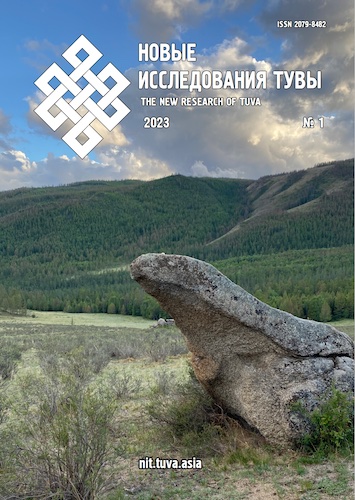The Tuvan language on the Internet: Representation, problems and prospects
DOI:
https://doi.org/10.25178/nit.2023.1.11Keywords:
Tuvan; digitalization of the Tuvan language; digital stability of the language; Internet; web spaceAbstract
The development of information and communication technologies has led to the extension of the sphere where the Tuvan language functions on the Internet. This article presents an overview of web resources in Tuvan, their problems and prospects.
While considering the representations of the Tuvan language, the authors classified Internet resources into four types: information sites, social networks and messengers, web services and online tools, mobile apps. For instance, it has been found out that only the website of the newspaper “Shyn” and the portal “Tyvanyn chogaalchylary — Writers of Tuva” offer an interface and full content in Tuvan. The official websites of Tuvan institutions do not have a Tuvan version of the interface and contain little information in the Tuvan language: the largest number of news items in Tuvan is presented on the website of the Government of the Republic of Tuva (45% of the total number of news), and the website of the Ministry of Economic development and Industry of the Republic of Tuva contains the least number of news items in Tuvan among the analyzed web resources (only 0.16%).
Despite the fact that Tuvan is one of the official languages of the Republic of Tuva, the scope of its functioning is limited. The difference between the demand for the Tuvan language on official websites and in social networks is evident. It can be observed that the authorities themselves do not actively use and develop the Tuvan language on the Internet, although they champion the development of the language. And without special state support the society seeks to expand the functioning of the Tuvan language on the Internet.
Tuvan is the language of communication in the VK social network and the Viber messenger. There are language tools for users who know Tuvan, including Wikipedia in Tuvan, online dictionaries, Tuvan keyboard layout, electronic corpus, a data collection platform for developing Tuvan online translation tools, and a morphological analyzer. There are also several apps available in the App Store and Google Play.
References
Bavuu-Surun, M. V. (2016) Voprosy sozdaniia elektronnykh resursov tuvinskogo iazyka: nekotorye itogi, neotlozhnye zadachi i perspektivy [Creating electronic resources on Tuvan language: Preliminary results, current challenges and prospects]. New Research of Tuva, no. 4, pp. 4–27. (In Russ.).
Gabdrakhmanova, G. F. and Mahmutov, Z. A. (2018) Natsional'nyi internet Rossii: k postanovke problemy [National internet of Russia: Problem statement revisited]. Oriental Studies, vol. 11, no. 3, pp. 142–151. (In Russ.). DOI: https://doi.org/10.22162/2619-0990-2018-37-3-142-151
Guseinova, A. V. (2017) Khakasskii iazyk v natsional'nom internet-prostranstve [Khakass language in the national Internet space]. Mir nauki, kul'tury, obrazovaniia, no. 5 (66), pp. 349–351. (In Russ.).
Dagbazhyk, A. S. (2016) Struktura slovarnoi stat'i Natsional'nogo korpusa tuvinskogo iazyka [The structure of an entry in the National corpus of Tuvan language]. New Research of Tuva, no. 4, pp. 36–44. (In Russ.).
Dalaa, S. M. (2016) EVM i tuvinskii iazyk: obzor issledovatel'skikh rabot Tuvinskogo gosudarstvennogo universiteta [Computers and Tuvan language: An overview of research at Tuvan State University]. New Research of Tuva, no. 4, pp. 28–35. (In Russ.).
Damba-Huurak, O. D. (2010) Pervyi tuvinoiazychnyi sait [The first Tuvan-language site on the Internet]. New Research of Tuva, no. 1, pp. 206–210. (In Russ.).
Kuzhuget, A. A. (2012) Perspektivy tuvinskoi «Vikipedii» [Prospects of Tuvan Wikipedia]. New Research of Tuva, no. 2, pp. 142–145. (In Russ.).
Lamazhaa, Ch. K. (2021) Sotsial'naia kul'tura tuvintsev i onlain-prostranstvo [Social culture of Tuvans and online space]. New Research of Tuva, no. 2, pp. 115–129. (In Russ.). DOI: https://doi.org/10.25178/nit.2021.2.10
Makhmutov, Z. A. (2015) Iazykovoi landshaft tatarskogo Interneta [The language landscape of the Tatar Internet]. Kazan, Academy of Sciences of the Republic of Tatarstan. 36 p. (In Russ.).
Makhmutov, Z. A. and Orekhov, B. V. (2014) Metodologicheskie i prakticheskie aspekty izucheniia natsional'nykh Internetov v Rossii [Methodological and practical aspects of studying national Internets in Russia]. In: Russkii iazyk i novye tekhnologii [Russian language and new technologies] / ed. by M. V. Akhmetova and V. I. Belikov. Moscow, Novoe literaturnoe obozrenie. 256 p. Pp. 189–199. (In Russ.).
Mongush, Ch. M. (2016) Metatekstovaia razmetka v Natsional'nom korpuse tuvinskogo iazyka: struktura i funktsional'nye vozmozhnosti [A metatextual markup in the national corpus of Tuvan language: The structure and functionality]. New Research of Tuva, no. 4, pp. 45–52. (In Russ.).
Oorzhak, B. Ch., Khertek, A. B., Kuzhuget, M. A. and Ondar, V. S. (2016) Semanticheskaia razmetka imeni dlia Elektronnogo korpusa tekstov tuvinskogo iazyka [Semantic markup of nouns and adjectives for the Electronic corpus of texts in Tuvan language]. New Research of Tuva, no. 4, pp. 53–65. (In Russ.).
Papyn, A. S. (2010) Tuvinskaia raskladka klaviatury [Tuvan keyboard layout]. New Research of Tuva, no. 1, pp. 19–25. (In Russ.).
Printsev, I. (2011) Raduga Tuvy [Tuvan rainbow]. New Research of Tuva, no. 2–3, pp. 305–307. (In Russ.).
Saaia, S. D. (2017) Sposoby sozdaniia komp'iuternogo interfeisa na tuvinskom iazyke (na osnove sotsial'noi seti «VKontakte») [Ways to create a computer interface in the Tuvan language (based on the VK social network)]. In: Elektronnaia pis'mennost' narodov Rossiiskoi Federatsii: opyt, problemy i perspektivy [Electronic writing of the peoples of the Russian Federation: Experience, problems and prospects] : Proceedings of the International research conference, Syktyvkar, March 16–17, 2017 / ed. by M. S. Fedina. Syktyvkar, Komi Republican Academy of Public Service and Management. 308 p. Pp. 173–177. (In Russ.).
Saitbattalov, I. R., Lukmanova, R. Kh. and Saitbattalova, Yu. A. (2022) Teonimicheskaia leksika v perevodakh Evangelii na bashkirskii i tuvinskii iazyki [Theonymic vocabulary in Bashkir and Tuvan translations of the Gospels]. New Research of Tuva, no. 4, pp. 137–145. (In Russ.). DOI: https://doi.org/10.25178/nit.2022.4.11
Salchak, A. Ya. and Ondar, V. S. (2020) Sozdanie russko-tuvinskogo parallel'nogo podkorpusa elektronnogo korpusa tuvinskogo iazyka: pervye itogi [Setting up a parallel Russian-Tuvan subcorpus within the electronic corpus of Tuvan language: Preliminary outcomes]. New Research of Tuva, no. 1, pp. 75–87. (In Russ.). DOI: https://doi.org/10.25178/nit.2020.1.6
Salchak, A. Ya. (2012) Elektronnyi korpus tekstov tuvinskogo iazyka [Electronic corpus of texts of Tuvan language]. New Research of Tuva, no. 3, pp. 110–114. (In Russ.).
Khiis, G. and Bavuu-Surun, M. V. (2016) Iazyk i fol'klor tuvintsev Mongolii v bazakh dannykh elektronnykh resursov na tuvinskom iazyke [Language and folklore of ethnic Tuvans in Mongolia in Tuvan electronic databases]. New Research of Tuva, no. 4, pp. 77–87. (In Russ.).
Holmes, D. (2005) Communication theory, media, technology and society. London, Sage Publications. 272 p.
Kornai, A. (2013) Digital language death. PLoS ONE, 8 (10): e77056. DOI: https://doi.org/10.1371/journal.pone.0077056
Makhmutov, Z. A., Sagitova, A. G. and Ibragimova, E. R. (2015) Russian and Tatar languages in official internet resources. International Review of Management and Marketing, vol. 5, no 4, pp. 154–159.
Published
How to Cite
For citation:
Ondar Ch. G., Dongak V. S., Mongush D. S. Tuvinskii iazyka v Internete: predstavlennost’, problemy i perspektivy [The Tuvan language on the Internet: Representation, problems and prospects]. New Research of Tuva, 2023, no. 1, pp. 186-207. (In Russ.). DOI: https://doi.org/10.25178/nit.2023.1.11
Issue
Section

This work is licensed under a Creative Commons Attribution-NonCommercial 4.0 International License.

Author(s) license holder(s) grant rights for their work to the journal (grantee of a license) under the simple non-exclusive open license in accordance with Art. 1286.1 «Open license for a research work, work of literature or fine arts», Civil Code of the Russian Federation.
New Research of Tuva publishes articles under the Creative Commons Attribution-NonCommercial license (CC BY-NC).
Since it is an open license, author(s) reserve the right to upload the article to their institutional repository, submit it to another journal (if it allows republications), or republish it on their own website (in full, or in part).
However, several conditions apply here:
a) The republished version must always contain the name(s) and affiliation(s) of the author(s), the original title and the hyperlink to the original version on the New Research of Tuva website;
b) It must be in open access, free of charge, and no category of readers must be in any way whatsoever advantaged over general readership.
c) should the contribution be submitted elsewhere by its author(s) without substantial modification (30% or more of original text unchanged), the body of the article should contain a disclaimer that the original version was published in New Research of Tuva (with a link to the respective page)
The CC-BY-NC is a non-revocable license which applies worldwide and lasts for the duration of the work’s copyright.











